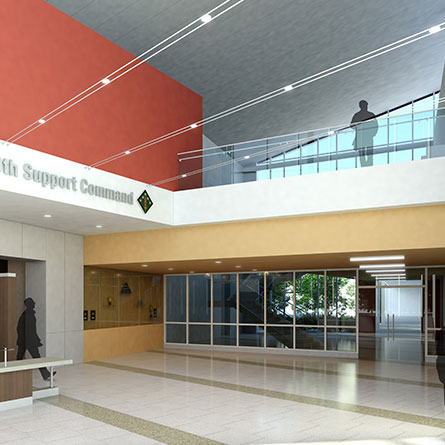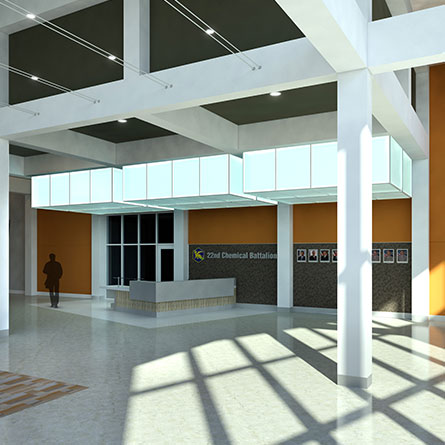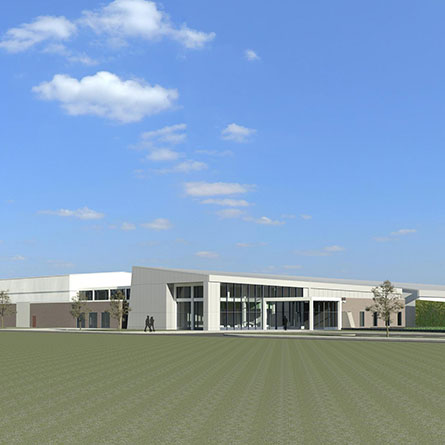20th CBRNE Command. Aberdeen Proving Ground, Maryland.
Promoting research and response readiness, the design of these two facilities focus on the training, operations, and coordination necessary to keep this command on the forefront of defusing CBRNEs and prepared for instant deployment to locations all over the world. Supporting these DoD mission critical operations, the 20th CBRNE Command facility encompasses an Emergency Operations Center, a Security Operations Center, a Network Operations Center, classrooms, training rooms, deployment and readiness bays, high bays for vehicle maintenance, offices, honor wall, and interior courtyards including a fallen solider memorial.



Services Performed
Project Highlights
Architecture
The design concept incorporated a campus feel between these two buildings as well as exuding a definitive presence on base. To create a visual link between the buildings, the same entrance canopy design and palette of exterior materials were used.
Interior Design
The interior design reflects the importance of the 20th Support Command mission and seamlessly incorporates a celebration of the unit’s history, commemoration of fallen soldiers, and integration of intelligence networks.
Civil/ Land Development
Grading, parking, storage area, utility infrastructure, stormwater management facility, and erosion and sediment control design was performed on this project. Services also included preparing and securing MDE/USACE permits/approvals for SWM/E&SC and for wetlands impacts.
Electrical
Power will be supplied to Buildings 5016 and 5046 at 1500KVA, 480Y/277V each. Interior and exterior lighting will be fluorescent and LED respectively. Emergency power consists of a 1500kW generator at one building, a 450kW generator at Building 5046, and flywheel UPS.
Fire Protection
Designed new fire sprinkler and standpipe systems for two buildings and provided fire pumps. Fire alarm and mass notification systems were designed to meet current government criteria. Extensive coordination was required due to low ceiling heights and deep beams.
Structural
A new foundation and superstructure was designed for the steel moment-framed two-story L-shaped, addition and framing retrofit the remaining portion of the maintenance building. A new one-story steel braced frame superstructure and foundation was designed to replace the classroom/administration space.
Mechanical
Design met LEED criteria through innovative wastewater technologies, water use reduction, optimized energy performance, outdoor air monitoring, refrigerant management, and sophisticated controls to implement building measurement and verification. Extensive coordination allowed the successful adaptive reuse of buildings with limited headroom.
Protective Design/Security
Developed comprehensive AT/FP strategy for renovation of two buildings. Set standoff distance to site parking; performed analysis on existing structure; specified blast-resistant glazing, windows, and doors; devised compliant metal stud/panel wall sections for actual standoff distances on an existing constrained site.
Mapping/GIS/Surveying
Topographic and utility location surveys were done for this facility. Survey control was based on APG monumentation (UTM Zone18). Survey data was processed to develop a DTM and one foot contours. The surveys were processed in MicroStation CADD using USACOE standards.
Sustainability
The two buildings are designed to achieve LEED Silver certification through self-certification by USACE. LEED self-certification will ensure compliance with UFC 1-200-02 and ASHRAE 189.1. Restroom fixtures were designed to achieve the innovative waste water technologies credit.
Technology
Design of the technology infrastructure included Category 6A UTP cabling along with single mode and multimode optical fiber. The telecommunications rooms were designed as well as the outside cable plant, inside cable plant, and pathway infrastructure. These areas were designed to support classified and unclassified networks.
